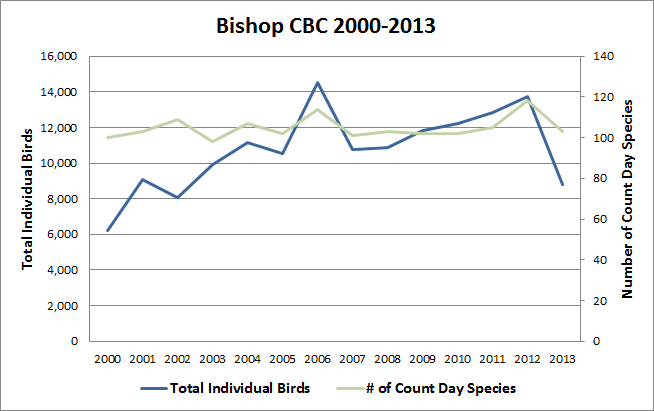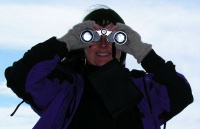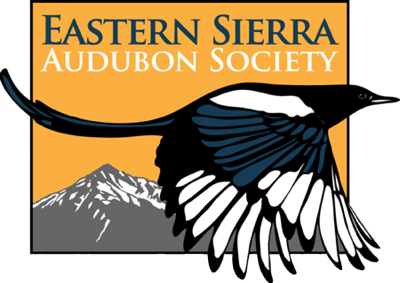
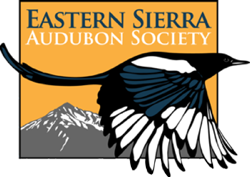
Sierra Wave
Newsletter
Volume 32, Number 3
January-February, 2014
Sierra Wave Newsletter
Volume 31, Number 4
March-April, 2013
Contents
- Events:
- Features:
- Reports:
- Business
Events
February 5th: Fall Explorations on Southeast Farallon Island with Kristie Nelson
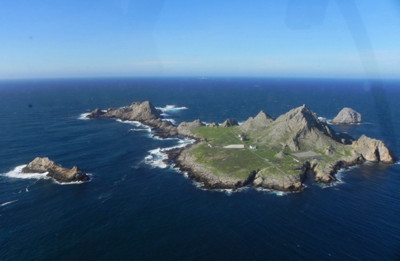
Southeast Farallon Island from the Air, Photo by Nora Livingston
Wednesday, 5 February 2014, U.S. Forest Service/BLM Building in Bishop, 7:00-8:30pm
Our February program will be held at the U.S. Forest Service/BLM Building in Bishop on West Line Street, near the DMV. Please welcome our guest speaker, Kristie Nelson, with Point Blue Conservation Science (formerly PRBO), who will be giving a presentation on the fascinating and diverse life-forms of the Farallon Islands. Doors open at 6:30, with the presentation starting at 7:00pm.
Fall Explorations on Southeast Farallon Island
Tiny Southeast Farallon Island, located 30 miles west of San Francisco and 5 miles from the edge of the continental shelf, is a world within itself. For over 45 years, biologists and interns with Point Blue Conservation Science have carefully observed and studied the myriads of life-forms that abound on this National Wildlife Refuge throughout the seasons. In summer the island is alive day and night with the commotions of colonial seabirds. In winter Northern Elephant Seals arrive; females birth their young and enormous males quarrel for dominance. And in fall, there is a little bit of everything….
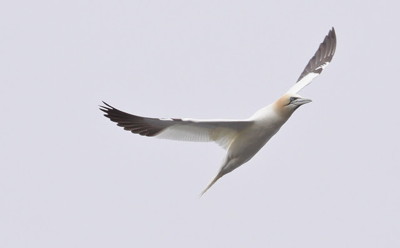
Northern Gannet - first Pacific Ocean record! This bird must have passed through an ice-free Northwest Passage to end up at the Farallones.
Photo by Sophie Webb
Land birds of all kinds, including mis-directed vagrants from distant lands, local storm-driven migrants, plus arrays of passing seabirds and whales, all can occur in great numbers when conditions are right. In addition to bird migration, fall brings one of the world’s largest Great White Shark populations to waters around the island. The above, along with migrant butterflies, dragonflies, “ballooning” spiders, and more, combine to make fall season on the Farallones one of the most remarkable places to be a naturalist.
Kristie Nelson has had a nearly obsessive love for birds since some of her earliest memories. She has conducted ornithological fieldwork throughout California, is an active birder and naturalist. She first came to the Eastern Sierra in 2000 working with PRBO (now Point Blue) Conservation Science, and has remained on the eastside working with PRBO/Point Blue ever since. She has served on the California Bird Records Committee since 2003, and has been the project leader for the California Gull Research Project on Mono Lake since 2005. When not engaged in bird work, she is busy running a small diversified farm with her husband Joel.
Future Programs (schedule subject to change):
- April (date and venue TBA): Bob and Susan Steele on Susan's Kern County Big Year in 2011
- June (date and venue TBA): Leila Harris, bat research and natural history
Everyone is welcome to attend all programs!
Questions/comments: programs@esaudubon.org; 760-920-8541.
Back to Top
Upcoming ESAS Field Trips and Other Events
Monthly Bishop Paiute Tribe COSA, Bird Walk and Census
[Ed. Note: COSA walks are held on the second Saturday of every month, unless otherwise indicated]
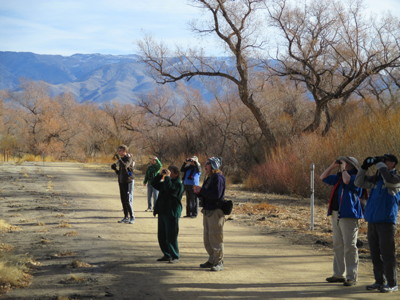
Birders at December's COSA walk
Our January Conservation Open Space Area (COSA) Bird Walk and Census will be held on Saturday, the 11th of January. The new Conservation Open Space Area is being developed for wildlife and the community by the Bishop Paiute Tribe. We'll be keeping species lists and observing behavior as well as identifying birds, for the purpose of creating bird lists for the site. Come and check out the new COSA and help census the birds that are using the area. For more information, read this article on the COSA in the March-April Sierra Wave newsletter. There have been surprises every month so far - come find out what new birds we'll see in January!
All are welcome - these walks are for birders of ALL LEVELS, beginners included! We will bring extra binoculars and field guides to share.
Please meet at 8:30am at the BLM/Forest Service Building on West Line Street in Bishop. Contact Jenny Richardson for more information, or if you are interested in leading a future monthly walk: programs@esaudubon.org or call 760-920-8541.
February's walk should be on Saturday, February 8th - watch the monthly email update, the field trips page on our website, or local media for confirmation, updates on leader(s) and meeting time. Or, contact Jenny (above), or if you just show up at 8 or so, you'll probably find us!
Back to Top
Features
President’s Message
“There are advantages to being self-taught,
The quality of instruction is not one of them.”
— Ted Leeson
One of our unexpectedly warm December days, I decided to pay a visit to the river near our house. Ostensibly, I went there to cast a few flies, but the real reason was just to be a part of the bright, clear and sunny day. Walking through the sagebrush, I would startle groups of small birds from their cover. As I got to the river, I came over a little rise to a willow stand along the slope to the water. As I came to the top of the slope, a bunch of birds flushed in front of me. As I stood there, a shape came gliding over my right shoulder and down toward the base of the willows. It was a Harrier that dipped so low that I could look down and see the white spot on its rump. I had been its bird dog. It was amazing and I was breathless. Whatever the reason I had gotten into the car no longer made any difference. I had been drawn into the living riparian web and one of its secrets had been revealed to me.
Over the past few years, I have sat through a lot of meetings in which people talked about the value of habitat. I have participated (everyone knows how I like to talk) and thrown out my own thoughts or opinions. As much as we have talked, no one has ever come close to describing those few seconds with the hawk. We talk about such things separately during the breaks, so I know that the people there have experienced such connections, but they do not get translated into the language of the meetings. I wish that the whole committee or working groups or whatever had been with me that day because I think it could have cut through a lot of conversation.
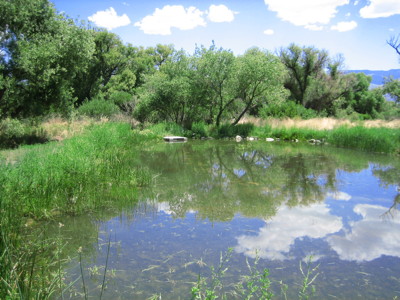
Pond at the COSA
I was out at the COSA a few weeks ago, sharing the place with a friend. It was late in the afternoon of one of those dramatic weather days with low scudding clouds drifting over and along the Sierra crest. This was a woodpecker day: Flickers, Nuttall's and maybe a Downy all appeared, busily working on the trunks of the stately old black willows. Although the wind came up raw and cold, our spirits were lifted by our presence in this place. Later, we talked about possible ways to get people involved in the natural world. Our conversation was really positive; filled with creative ideas and practical ways to get things done. It was a worthwhile investment of time. Would this meeting have been as productive if we had not started it among the clouds, trees and birds? I don’t think so.
One of the great values of habitat is that it provides a setting in which we can individually and collectively transcend our perceived limitation; to truly find connections, even if they are transient, with greater forces at work around us. At dinner with friends on the Solstice, we talked about the Ohlone people who would rise before dawn so that they could great the rising sun as a community. The purpose was to express thanks for the new day. This was done every day – a constant reminder of the crucial importance of what we see as the most commonplace daily event, a communal recognition that every day is dependent upon factors beyond our reckoning and control.
It is the Audubon way to highlight the fabric of the world around us – the big and small, the rare and beautiful and the more mundane. We remind ourselves of the amazing movements of birds as we count them at Christmas. Data from these counts caution us that a threat to the health of a winged species is a threat to us as well; we enhance our own future as we preserve that of our fellow creatures.
This tradition and the role of ESAS in our community make being President of the chapter a great honor. It is the day after Christmas and I have been repeatedly reminded during this season of the fact that I am incredibly blessed. I live in a magnificent place, and I am involved in valuable work. Over and over again, during the last month, I have had the experience of talking with amazing people I have met through Audubon. Whether at the chapter holiday dinner, running into people at the store, at parties and yes, even at those meetings, I have become a part of a web of concerned, intelligent people looking to do the right thing. I am so grateful for the opportunity to be with you.
Pete Pumphrey
Back to Top
Fall Migration in Inyo County-Version 2013
[Birds in bold type have a photo in the article (or linked) - click on any photo to see all in a slideshow]
By Tom & Jo Heindel
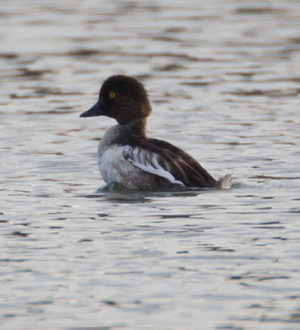
Common Goldeneye, photo by Steve Brad
Another year has passed in the Eastern Sierra and, as always, many interesting birds made their way to our beautiful spot on Planet Earth. For the journal North American Birds, the fall season extends 1 August to 30 November. In reality, southbound migrants begin arriving in June (Wilson's Phalarope, Rufous Hummingbird, etc.) and extend exceptionally into December (Black-and-White Warbler, Hammond's Flycatcher, etc.).
The Fall Season broke records because of the dedication of a group of field observers who provided evidence for their "outlandish" claims. The earliest ever Common Goldeneye was photographed at Little Lake 11 September (SKB) and a very late Turkey Vulture, rare after the first week of October, was photographed at Lone Pine 20 November (RDK). Shorebirds of note included Solitary Sandpipers with one photographed at Bishop 7 August (J&DP) and two birds, one photographed, at Deep Springs 7 September (SLS, C&RH), two Sanderlings, one photographed, at Owens Lake 11–17 August (B&SS, C&RH), and Pectoral Sandpipers, at Owens Lake 20 August (C&RH) and Klondike Lake 30 September (T&JH). The only Semipalmated Sandpipers were two birds at Owens Lake 11 August (B&SS). The last water bird was a juvenile Sabine's Gull photographed at Tinemaha Reservoir 28 September (J&DP, R&NO).
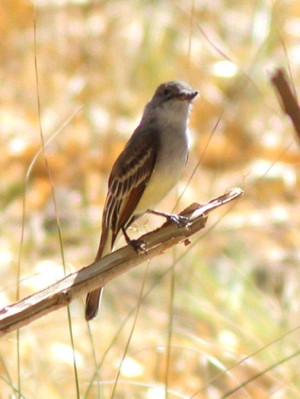
Ash-throated Flycatcher, Photo by Debby Parker
Three dove types of interest were documented. A Band-tailed Pigeon photographed at 10,400 ft near Schulman Grove, White Mountains, 10 August (SLS, R&NO), a White-winged Dove photographed at Lone Pine 8 September (RDK) and a Common Ground-Dove photographed at Deep Springs 27 August (C&RH). Three surprising woodpecker species made appearances with Lewis's Woodpecker at Aspendell, one bird at 8500ft, a new high elevation record for Inyo County, 30 August (B&SS), eight birds, one photographed, at Lone Pine 30 September (RDK), and eight birds at Furnace Creek Ranch 30 October (MjSM), followed by an Acorn Woodpecker at Aspendell 5 September (B&SS) the northernmost record for the county, and a Northern 'Yellow-shafted' Flicker photographed at Furnace Creek Ranch 20 October (C&RH).
A rare-in-fall Dusky Flycatcher was recorded at Deep Springs College (restricted access) 19 September (JLD) and an Olive-sided Flycatcher at Rovana tied the latest record ever for the species on 9 October (JLD). A very late, unexpected after August, Ash-throated Flycatcher was photographed in Bishop 6 October (J&DP) and three Vermilion Flycatchers were scattered throughout the county with one bird at Deep Springs (SLS), one bird photographed at Lone Pine (RDK), and another photographed at Shoshone (C&RH). The only vireo of note was a Red-eyed Vireo photographed in Bishop 20 September (CBG, LSN). There were two Pacific Wrens, one photographed in Bishop 26 September (C&RH, J&DP) and another bird at Aspendell 26–30 November (WHM, B&SS).
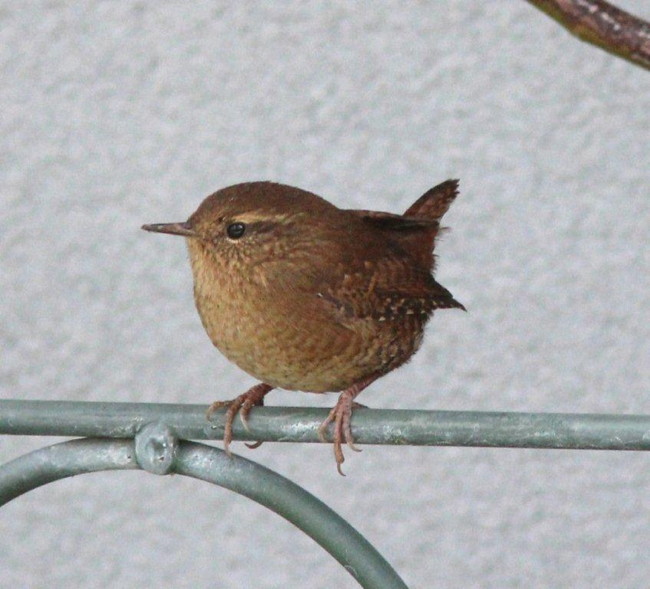

Pacific Wren, photo by Debby Parker
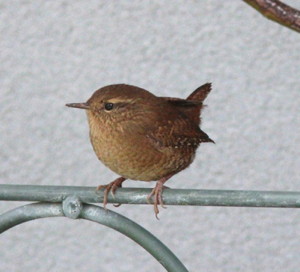
Pacific Wren, photo by Debby Parker
It is easy to think that if a migrant is very common in one season, they are likely very common in the other season. That often is the case but not with Swainson's Thrush. This common spring migrant is very rare in fall in the Eastern Sierra, thus the one bird at Aspendell 5 September was noteworthy (B&SS).
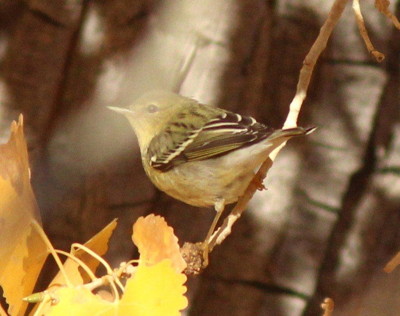
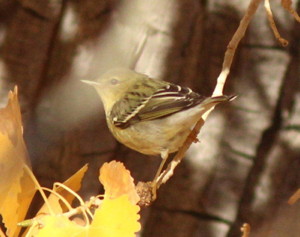
Blackpoll Warbler, photo by Debby Parker
And then there are the warblers…that colorful family that makes birder's hearts and legs race. It was an exciting fall with many notable records scattered high and low and far and wide. The rarest was a Louisiana Waterthrush photographed at Shoshone 4 September (JEP) and it's more common, but rare relative, the Northern Waterthrush was photographed in Bishop 24 October (J&DP, R&NO). A photographed Black-and-white Warbler remained at Bishop City Park 16 October–5 November (C&RH, R&NO, J&DP, DJH, ADeM) and a photographed Prothonotary Warbler lingered in a Lone Pine yard 21 September–6 October (RDK). On one hike in the Bishop Lake area, 11,4000ft, two highest ever elevation records were set. On the way in a MacGillivray's Warbler was recorded near the lake 2 September and on the way out an Orange-crowned Warbler was near the same lake 7 September (WDS). Two female/immature male Northern Parulas were recorded with one bird at Lone Pine 30 August (RDK) and another at Furnace Creek Ranch 30 October (MjSM). A Virginia's Warbler appeared in Rovana 31 August (JLD) and while a regular breeder on the east slope of the White Mountains, the species is only rarely reported in the Owens Valley. An immature male American Redstart was photographed at Coso Junction 28 September (SKB), a very rare Bay-breasted Warbler was photographed at Diaz Lake 18 November (RDK), a late Blackpoll Warbler was photographed at Bishop 16 November (J&DP), and a Hermit Warbler was photographed at Coso Junction 13 October (KHL) tying the latest record ever.
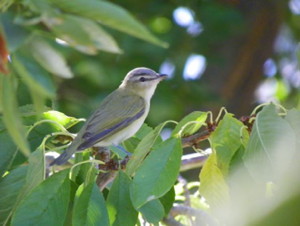
Red-eyed Vireo, photo by Carolyn Gann
Sparrows were well represented with a Clay-colored Sparrow photographed at Furnace Creek Ranch 18 October (C&RH), one Swamp Sparrow at Furnace Creek Ranch 11 November (DS) and another photographed at Pleasant Valley Reservoir 24 November (J&DP). Seven White-throated Sparrows were documented and photographed between 10 October and 25 November and a Harris's Sparrow was photographed at Furnace Creek Ranch 20 October (C&RH) and was reported there again 30 October (MjSM). 'Pink-sided' Juncos were reported at Big Pine 14 November (T&JH) and Starlite, W of Bishop 27 November (DVP, LBH) and a 'Gray-headed' Junco, casual in the Sierra Nevada, was at Aspendell 9 November (SLS).
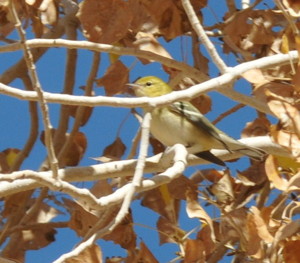
Bay-breasted Warbler, photo by Russell Kokx
Three Summer Tanagers were scattered throughout the county with one at Aspendell 11 August (B&SS), one at Lone Pine 20 August (RDK), and one at Crystal Spring in the Kingston Range 11 September (JEP). Four Indigo Buntings were scattered throughout the Owens Valley, one adult male at Rovana 11 August (JLD), one male at Lone Pine 20 August (RDK), one female Deep Springs College (restricted access) 28 September (B&SS, R&NO), and an adult male at Birch Creek, near Big Pine, 26 November–2 December (JEB). Orioles of note included an immature male Baltimore Oriole at Rovana 18 September (R&NO, JLD) and an Orchard Oriole photographed at Rovana 18 September (JLD, R&NO) and another one photographed at Big Pine 8 October (T&JH), both birds were female/immature male types. Lastly, are a Lawrence's Goldfinch at Deep Springs 28 September (R&NO) and an Evening Grosbeak in Big Pine 17 November (T&JH).

Black-and-white Warbler, photo by Nancy Overholtz

Black-and-white Warbler, photo by Nancy Overholtz
And a final note for all the thrasherophiles…Rick & Karen Scott's Curve-billed Thrasher was photographed monthly from August through 23 November!
Kudos to the following bird data gatherers who are leaving behind more than wind-blown rumors of what they saw: [initials alphabetized by first name] ADeM–Al DeMartini, B&SS–Bob & Susan Steele, CBG–Carolyn Gann, C&RH–Chris & Rosie Howard, DJH–Debbie House, DS–Dennis Serdehely, DVP–David Vander Pluym, J&DP–Jim and Debby Parker, JEB–Jan Bowers, JEP–Jim Pike, JLD–Jon Dunn, KHL–Kelli Heindel-Levinson, LBH–Lauren Harter, LSN–Larry Nahm, MjSM–Michael San Miguel, Jr., RDK–Russell Kokx, R&NO–Ron & Nancy Overholtz, SKB–Steve Brad, SLS–Susan Steele, WDS–Dave Shuford, and WHM–Bill Mitchel.
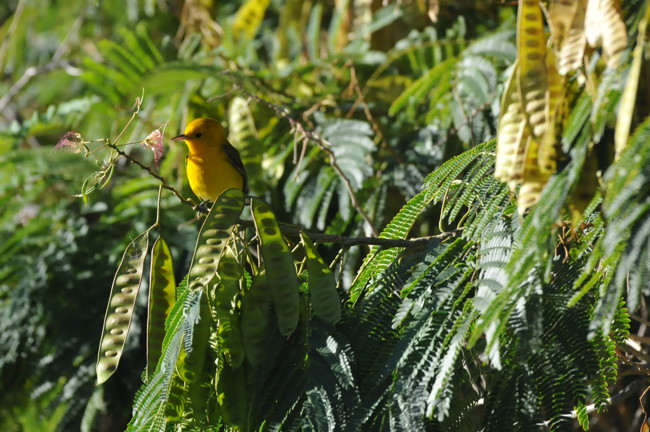
Prothonotary Warbler, photo by Russell Kokx
Back to Top
Flutterings (Nature-inspired writing and images)
A space for things that make our hearts go pitter-pat!
Sunset, January 9, 2014
Their backs to the sunset, a flock of Bushtits, whispering and twittering, flows through the willows like a soft gray tide. Their urge to feed on insects and seed is greater than my need to feed on beauty.
William Dawson wrote in 1923, "Bushtits are bird children that never grow up ...To see a flock of these merry mites trouping over the bushes, you would think they were playing an endless game of tag."
And from Birds of the Sierra Nevada, "Bushtits create exquisite and remarkable abodes: long, soft pouches woven from lichens, mosses, willow down, spiderwebs, or feathers, decorated with flower blossoms or moth's wings.”
Rosie Howard
(Facebook, January 9, 2014)
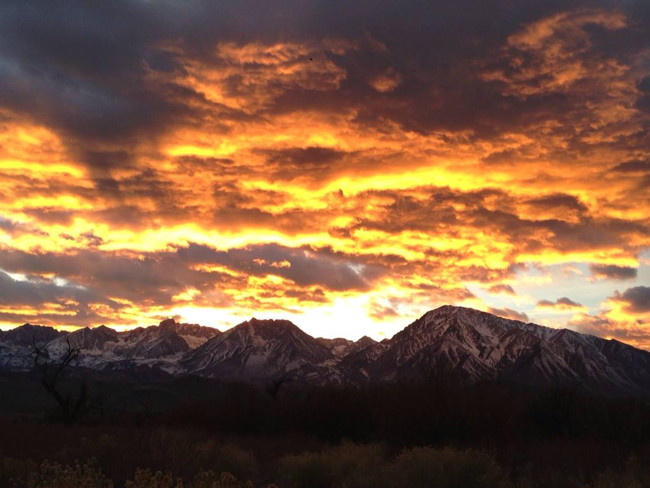
Bishop Sunset, photo by Rosie Howard
Back to Top
Reports
Thank You to Ros and John Gorham for their Adopt-a-Highway Work!
Eastern Sierra Audubon participates in California Department of Transportation’s “Adopt-a-Highway” program. The two mile section on Highway 395 heading north from near Tom’s Place marks where two intrepid volunteers have worked to keep a beautiful stretch of highway just that, clear-of-litter beautiful.
Ros and John Gorham, Eastern Sierra Audubon members, have coordinated this effort to keep the highway clear of litter for the past 15 years. Sometimes with friends helping and other times tackling the job alone, Ros and John Gorham have made a great community contribution. They recently made their last sweep of the Highway 395 corridor. As of January 2014, they will be stepping down from this important task.
The Adopt-a-Highway Program started in 1989. CalTrans documents show that over the years more than 423,000 cubic yards of litter and debris have been collected, “...or enough trash to fill a line of dump trucks, parked bumper-to-bumper, from San Francisco to San Luis Obispo.” Fifteen years of diligent work on the Gorham's part contributed to that huge figure and has kept the highway clear of litter, at least for a period of time.
Let us all applaud the work done by Ros and John Gorham and give them heartfelt thanks for their important 15 year contribution in the name of Eastern Sierra Audubon.
Ann Hoffmann
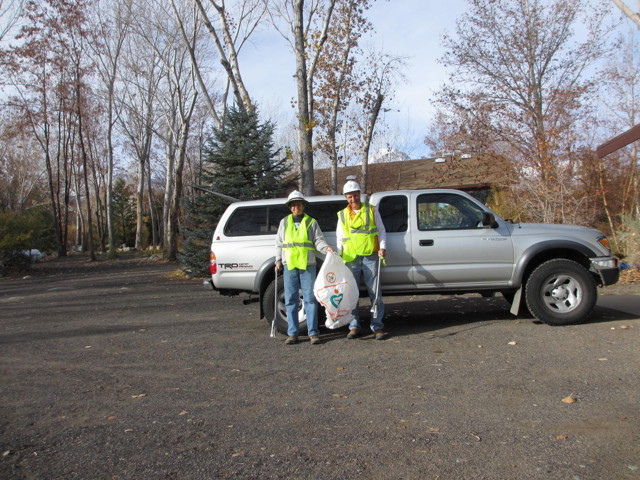
Ros and John Gorham at work
Back to Top
Adopt-a-Highway Program Volunteer(s) Needed
Help is needed to continue Eastern Sierra Audubon’s participation in the Caltrans Adopt-A-Highway Program. The two mile section which has been maintained for the past 15 years by Ros and John Gorham is located at Post Mile Marker 10.3 north to Marker 12.3 on Highway 395. This section is near Tom’s Place. Eastern Sierra Audubon has a sign located on the highway indicating ESA’s sponsorship for litter removal on this two mile stretch.
James Reese, Caltrans District 9’s Adopt-A-Highway Coordinator, is the contact person in Bishop. He may be reached at 760-872-0790 or James.Reese@dot.ca.gov. James will be able to answer questions for anyone considering volunteering to maintain the program. You may also contact Ann Hoffmann, Secretary, ESA, at 760-933-2318.
An orientation between the Caltrans McGee Creek supervisor and the main contact for an adoption group is mandatory primarily to address safety rules. Equipment such as bags, helmets, safety vests are provided. It is the responsibility of the main contacts to pass along and instruct safety concerns to their participants.
Caltrans encourages litter removal take place four times a year. If four separate people gathered together and committed to a once-a-year contribution, our commitment to Adopt-A-Highway could continue, the roads would be cleaner, and personal contribution just feels right. Please consider calling James or Ann. Adopt-A-Highway is a good program to support.
Ann Hoffmann
Back to Top
2013 Christmas Bird Count Results
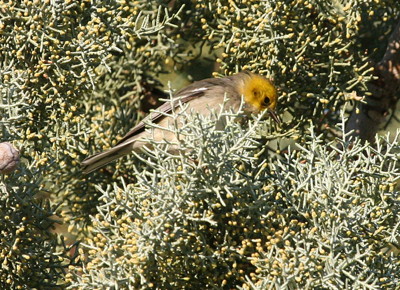
Hermit Warbler, photo by Kelli Levinson
(not seen on the CBC, but the photo looks "Christmasy"!)
The 32nd annual Bishop Christmas Bird Count was held December 14, 2013, a nearly windless and sunny day with amazingly balmy temperatures (low 23F, high 62F). A record 68 birders in 12 teams tallied 103 species with a total of 8,790 individual birds. Overall, teams felt birds were fairly scarce this year - that feeling is reflected in the table and graph below. Compared to recent years, both the species count and the total individuals count were depressed. The lower totals were certainly, at least in part, due to the cold temperatures in early December. An example of the depressed numbers is found in the Orange-crowned Warbler: this year we tallied four individuals, compared to fifty-four and thirty-one in 2011 and 2012, respectively.
The count did have some notable highlights. A Greater Yellowlegs was found on the Owens River from the Highway 6 bridge (Peterson). Two Barrow's Goldeneye were new to the count, found at the Bishop Sewer Ponds (Heindel). Three Double-crested Cormorants were at Pleasant Valley Reservoir (Mazza). A flock of white geese including fifty-two Snow Geese and three Ross's Geese were over Round Valley, helping set the new Snow Goose high count (Dunn/House). An immature Black-crowned Night-Heron was at Pleasant Valley Campground during count week (Parker). There was one Rough-legged Hawk in Round Valley (Dunn/House). We established the new high count for Red-shouldered Hawks at twenty-six. For once, there was no shortage of Greater Roadrunners, with four tallied. A record twelve Great-horned Owls were found. A Western Screech-Owl was in Finkbeiner Forest (Pandolfino/Kelley/Vocelka). A female Williamson's Sapsucker was found during count week in a downtown Bishop backyard (Behr). Two Merlins were of the medium-dark race, columbarius. Prairie Falcon was missed on count day, but found during count week. No Western Scrub-Jays were tallied on count day or count week. Hermit Thrushes made a good showing, establishing the new high count at five. Western Bluebirds were in the count circle during count week, but missed count day. A meager four Orange-crowned Warblers were found. Vesper Sparrow made an appearance count week, but was missed on count day. Several teams tallied good-old-fashioned "Sage Sparrows" and a couple teams had good scope views and enough confidence to determine they had the newly split Bell's Sparrow. Sagebrush Sparrow, the other "Sage Sparrow," was not recorded, but expected to winter in the circle. We struck out on Fox Sparrows altogether, though two Golden-crowned Sparrows were found along the Owens River (Santiago/Phillips). One of the rarer Dark-eyed Junco races, the "Pink-sided" was encountered in Round Valley (Dunn/House). Cassin's Finches were nowhere to be found. Great-tailed Grackles no longer appear to winter in Bishop.
Many, many thanks to all the talented and generous people who contribute to the Bishop CBC! Mark your 2014 calendar for the next Bishop CBC on Sunday, December 14, 2014.
Chris Howard, Bishop CBC Compiler
| Year |
2000 |
2001 |
2002 |
2003 |
2004 |
2005 |
2006 |
2007 |
2008 |
2009 |
2010 |
2011 |
2012 |
2013 |
| # Participants |
25 |
29 |
35 |
39 |
52 |
45 |
45 |
41 |
47 |
56 |
44 |
52 |
61 |
68 |
| # Species |
100 |
103 |
109 |
98 |
107 |
102 |
114 |
101 |
103 |
102 |
102 |
105 |
118 |
103 |
| Total Individuals |
6197 |
9085 |
8085 |
9898 |
11160 |
10549 |
14508 |
10740 |
10861 |
11812 |
12209 |
12843 |
13759 |
8790 |
Back to Top
Taking Care of Business
Welcome New and Rejoining Members!
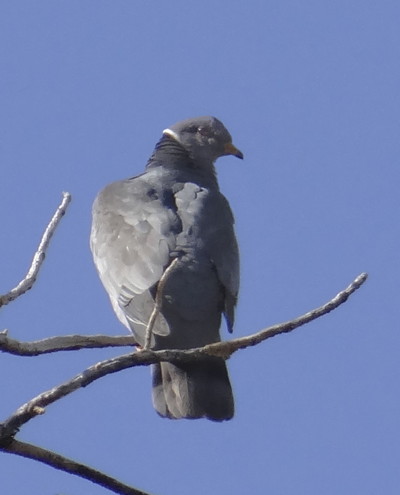
Band-tailed Pigeon, photo by Nancy Overholtz
Thank you to the members who joined or renewed their membership!
We'd like to take a moment to promote Chapter Memberships: You may not be aware of this, but 100% of Chapter Membership dollars stays locally in the Eastern Sierra, supporting local education, youth, conservation, and programs. If you don't need Audubon Magazine, consider joining or renewing as a Chapter-only member, or better yet, as both Chapter and National! We do get support from National Audubon, as well, so any membership helps, and is money well-spent toward bird and wildlife conservation and education, and we thank you!
Your membership donations help keep this chapter alive. We get 8-10 renewing members a month, and from 3-5 new members. Your membership dues make it possible for us to offer and support great educational and recreational events throughout the eastern Sierra. Thank you!
If you would like to join and help support Eastern Sierra Audubon, there are two ways you can do it:
- Join as a National Audubon Society Member, designating ESAS as your chapter affiliation. Includes Audubon Magazine subscription. This is $20 for the first year, and goes up to $35 annually thereafter.
- Join as an ESAS Chapter-only Member for $20 per year. 100% of your donation stays here in the Eastern Sierra this way. Your chapter membership is a way to give back, and show your appreciation for all that ESAS does, and to help support our mission locally. Your membership helps pay for scholarships, programs, special events, education programs, research, and more. THANK YOU for your support!
Click Here for a membership form to join or renew!
Join National Audubon - your zip code will associate you with the chapter nearest you.
Back to Top
How You Can Help ESAS: Four R’s (and a V)
Renew your membership (or join): The money from your membership dues is what helps us bring great evening programs, special events, - educational programs, trips, this website, and more to the community - we need your support!
Recycle at Manor Market and tell them to donate the money to Eastern Sierra Audubon.
Respect property and get permission to bird on private or restricted access property.
Repeat: Spread the word about programs and events, encourage others to join and participate.
Volunteer: Come to a board meeting and consider volunteering for an open board position! We welcome new board members, and we also always need volunteers for Birds in the Classroom, participants in bird counts, Bird-A-Thons, etc.
Message from the Editor
Our next newsletter deadline will be February 15th for the
March-April issue, and of course you are always welcome to send submissions for future newsletters
and also the monthly email at any time.
We send out about one email each month to remind you of upcoming events - if you are not
on our email list, please
add yourself so you don’t miss anything!
If you send items to the newsletter
editor by the last week of any month, we’ll make sure they get included in
the next issue.
All of our content is supplied by our awesome members... if you have any ideas about articles you’d like to see, or better yet, if you have anything to share for newsletter publication, whether an article, a news item, update, correction, poem, essay, artwork, photo, field trip report, neat birding experience, letter, etc, please send it, along with any comments or suggestions, to the newsletter
editor. We’d love to hear from you!
You may send items for inclusion in the newsletter at any time, but please
send any timely items to arrive before the first of the month, so they can
be included in the monthly email update.
Thanks for reading, and happy birding!
Maggie Wolfe Riley, Newsletter Editor
Back to Top
Calendar for January-February
Back to Top
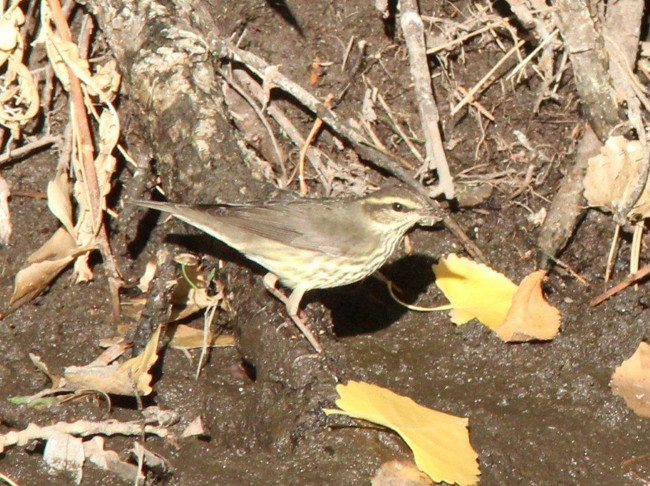
Northern Waterthrush, photo by Debby Parker
Back to Top





















